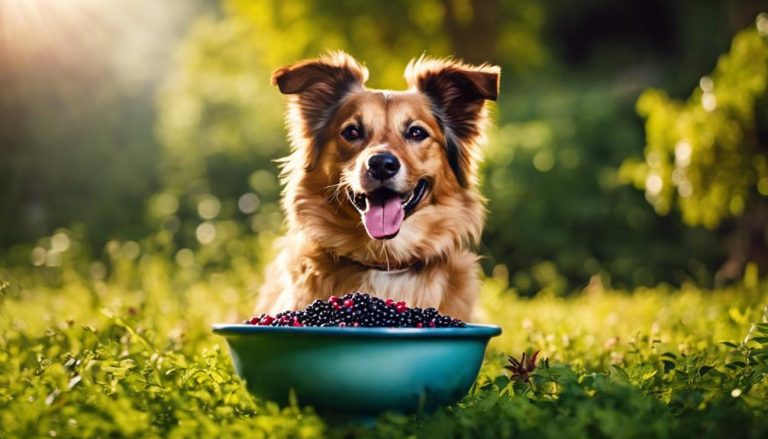Dogs and Elderberries: Safety Precautions
Elderberries might look harmless and are certainly healthy for people, but they pose a hidden threat to dogs. They contain cyanogenic glycosides, which can turn into cyanide once eaten. This makes them extremely dangerous for our canine friends. If a dog eats elderberries, they might start vomiting, have diarrhea, feel abdominal pain, and drool excessively. These symptoms are serious and require immediate attention from a vet.
The difference between how elderberries affect humans and dogs is a critical piece of knowledge for pet owners. To keep your dog safe, it’s best to avoid giving them elderberries. Instead, consider safe fruits like blackberries and rose hips, which don’t carry the same risks. Understanding what foods are safe is crucial for maintaining your dog’s health and wellbeing.
Key Takeaways
- Elderberries are toxic to dogs due to cyanide.
- Vomiting and diarrhea result from dogs eating elderberries.
- Choose blackberries or rose hips instead for dog treats.
Elderberry Toxicity in Dogs
Elderberries are well-known for their health benefits in humans, but they pose a serious risk to dogs due to the presence of cyanogenic glycosides. These compounds can release cyanide when ingested, which is highly toxic to dogs. It’s crucial to keep our canine companions away from elderberries and any related products to avoid the risk of cyanide poisoning.
Cyanide poisoning can have severe effects on dogs, leading to symptoms like vomiting, diarrhea, and abdominal pain. In extreme cases, it can be deadly. As dog owners, it’s our responsibility to ensure the safety of our pets by preventing their access to these dangerous berries.
Identifying Elderberry Plants
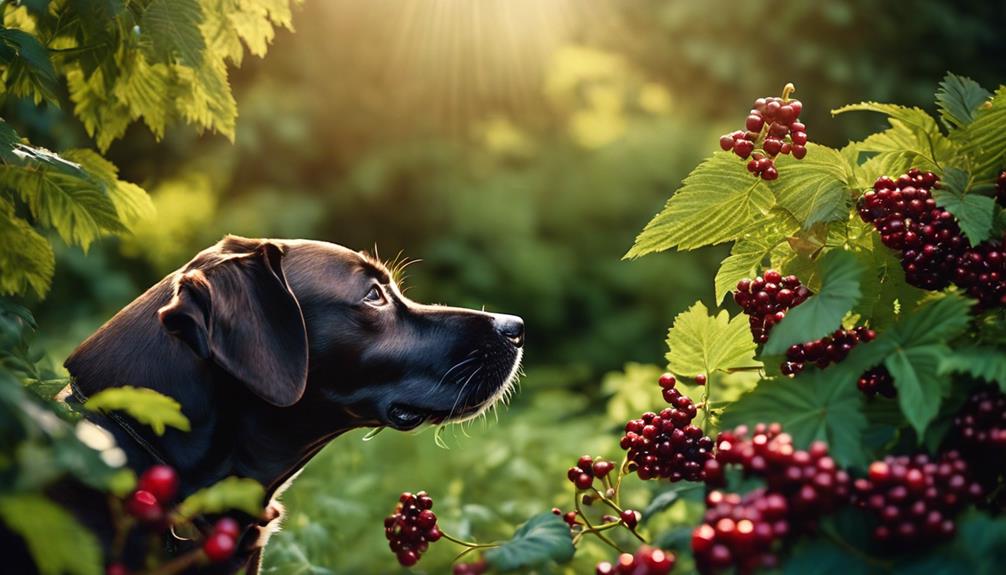
For the safety of our dogs, it’s crucial to recognize elderberry plants accurately. These plants, which are part of the Sambucus family, have specific features we need to look out for to prevent our pets from consuming something potentially harmful.
Elderberry plants stand out because of their umbrella-shaped flower clusters. These clusters are made up of many small flowers that are either white or cream-colored. This characteristic is a major hint that you’re looking at an elderberry plant. The leaves of these plants also help in identification. They are compound, meaning they are made up of multiple leaflets, usually between 5 and 9, and they have serrated edges. The leaves are placed opposite each other on the stem, which is another detail to help identify them.
The berries themselves are a tell-tale sign. They are small, dark, and grow in clusters. When ripe, they turn a deep purple to black color. Although these berries are toxic to dogs, leading to potential cyanide poisoning, they’re easy to spot once you know what you’re looking for.
Understanding these features is not just about plant identification; it’s about keeping our dogs safe from poisonous plants. By knowing what to look out for, we can ensure our pets stay healthy and avoid the dangers of toxic berries.
Symptoms of Elderberry Poisoning

Understanding how elderberry poisoning affects dogs is crucial for their well-being. Elderberry parts contain cyanogenic glycosides, which can cause cyanide poisoning, showcasing various alarming signs that require quick action.
| Symptom | Cause |
|---|---|
| Vomiting | Cyanogenic glycoside |
| Diarrhea | Cyanogenic glycoside |
| Abdominal Pain | Cyanide toxicity |
Symptoms such as excessive drooling and weakness are serious and indicate the need for immediate veterinary care. These signs can progress quickly, sometimes leading to fatal outcomes if not addressed swiftly. Early recognition and treatment are key to helping an affected dog recover from elderberry poisoning.
Immediate Actions After Ingestion

If you find out your dog has eaten elderberries, it’s vital to get in touch with a vet or a poison control center right away. They can guide you through what to do next to avoid the serious risk of cyanide poisoning from the berries.
Here’s what to do to keep your dog safe:
- Give all the details you can about how much your dog ate and any odd behaviors you’ve noticed.
- Be ready to explain what the elderberries looked like, including their color and shape, and if they were in any kind of package.
- Follow the expert advice you get on how to treat your dog to lower the chances of poison problems.
Reacting quickly and following expert advice are key to looking after your dog’s health if they eat elderberries.
Treatment Options Available
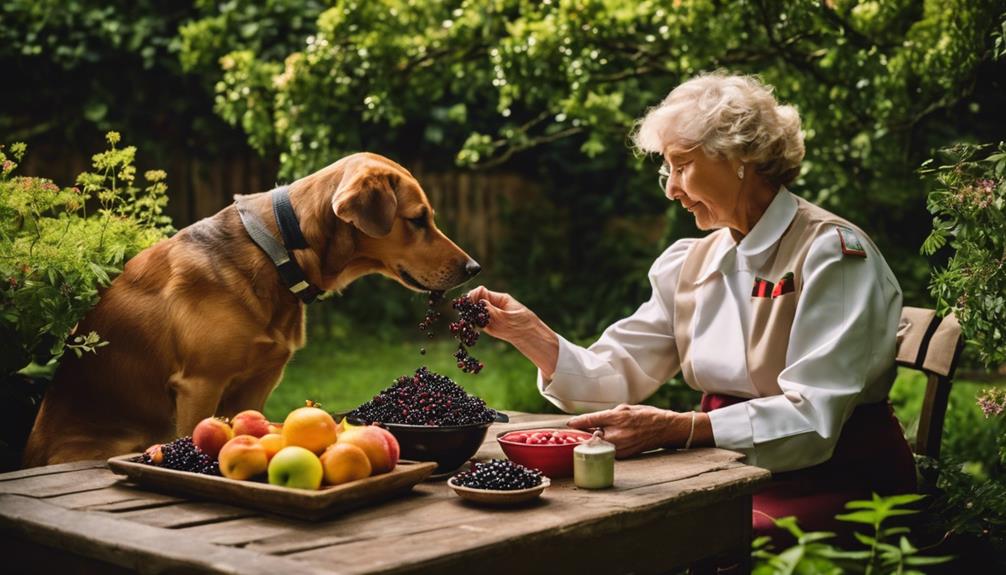
When a dog eats elderberries, we need to act quickly to help them. This guide will cover vet care, home remedies, and diet changes aimed specifically at helping dogs who’ve eaten these berries. We’re going to keep things straightforward and emphasize why it’s always smart to seek a vet’s help.
Vet Care Solutions for Dogs: If your dog has eaten elderberries, a vet can provide the best care. They might induce vomiting or give activated charcoal to absorb toxins, depending on how recently the berries were eaten. This step is crucial because it directly tackles the problem.
Home Remedies: While waiting for professional help or for mild cases, you can give your dog small amounts of water to help dilute the toxins. However, always check with a vet before trying any home treatment. This advice is practical because it’s a simple, initial step you can take.
Diet Adjustments: After a dog has ingested elderberries, feeding them bland food like boiled chicken and rice can help settle their stomach. This approach is beneficial because it’s gentle on their digestive system while they recover.
We’ve outlined clear, actionable steps to take if your dog eats elderberries. Always prioritize getting them to a vet, but knowing these additional strategies can further support your dog’s recovery.
Veterinary Care Solutions
When dogs eat elderberries, they might get sick because of something called cyanide in the berries. It’s really important for a vet to see them quickly to start the right treatment, which can help them get better. Making the dog throw up and giving them a special medicine called activated charcoal can help get rid of the poison.
Intravenous fluids are a big help too, as they keep the dog stable and help with the cyanide poisoning symptoms. Depending on what symptoms the dog has, they’ll get specific treatments to help them recover. Keeping a close eye on them to catch any new problems early is also key.
Getting help early and following the vet’s advice can make a big difference for dogs who have eaten elderberries. This approach gives them the best chance at a full recovery from the poisoning.
Home Remedy Approaches
When it comes to treating elderberry poisoning in dogs, it’s crucial to prioritize veterinary care over home remedies. Home treatments might miss the mark, leading to worsening health conditions for your pet. Quick and professional medical attention is key to managing the situation effectively.
| Treatment Aspect | Role in Managing Elderberry Poisoning |
|---|---|
| Veterinary Care | Vital for correct diagnosis and cure |
| Activated Charcoal | Used by vets to neutralize toxins |
| Intravenous Fluids | Crucial for detoxifying the body |
| Symptomatic Care | Helps relieve discomfort |
| Supportive Care | Necessary for full recovery |
Ignoring the need for a vet and trying to handle elderberry poisoning on your own can delay essential care. It highlights why expertise and scientific methods are indispensable in such emergencies.
In emergencies involving your canine companions, reaching out to a professional should always be your first step. This ensures not only the accurate identification of the issue at hand but also the application of the right treatment to get your dog back on its paws. Remember, in the face of toxic ingestion, the quicker you act, the better the outcomes tend to be.
Diet Adjustment Strategies
After a dog eats elderberries, changing its diet is essential to help it recover and avoid more issues. Working with a vet is key here.
Remove all elderberries and related products from your pet’s diet immediately. This stops more problems from happening. Watch your dog closely for signs of trouble like vomiting or feeling weak. This helps catch any issues early.
Following your vet’s advice on what your dog should eat is critical. Keep up with regular vet appointments to fine-tune your dog’s diet as needed. These steps significantly reduce the danger of complications from elderberry ingestion. They show why vet care is so important for your dog’s health and recovery.
Recovery and Management
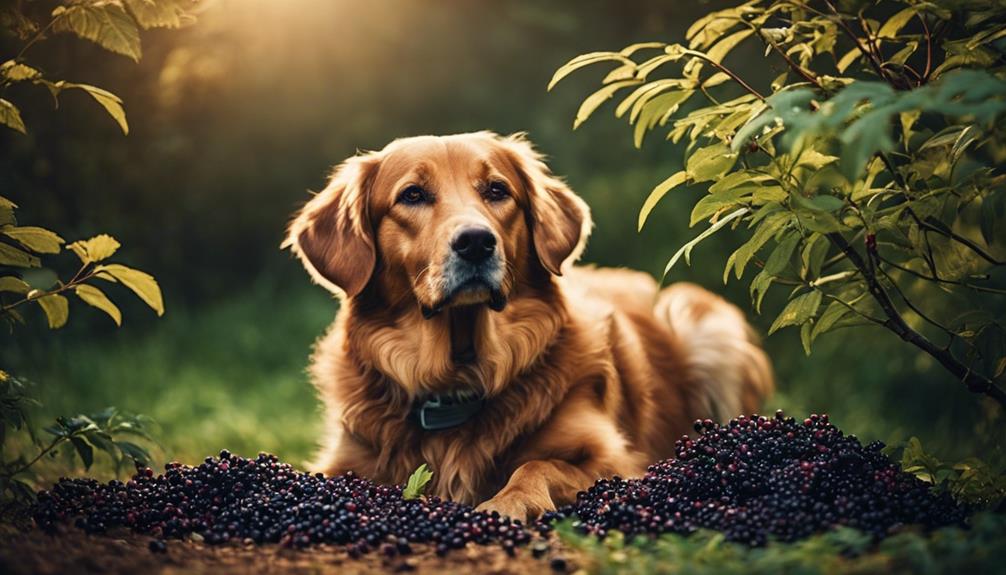
Recovering from elderberry poisoning in dogs is crucial and depends heavily on how quickly they receive medical help. The health of the dog plays a significant role in their recovery journey, requiring careful monitoring after treatment to ensure they’re on the mend.
A comprehensive treatment strategy, possibly including a special diet to aid recovery, is part of the recovery process. Watching for any signs of complications after the dog seems better is important because issues can pop up unexpectedly.
Making sure dogs can’t get to elderberries again is critical to avoid another poisoning incident. Regular visits to the vet are important to check on the dog’s recovery progress, make any necessary adjustments to their care, and protect their health in the long term.
Following these steps closely helps ensure a smoother recovery for dogs who have suffered from elderberry poisoning.
Safe Berry Alternatives

Ensuring the safety of our canine companions involves being mindful of the foods they consume. One way to do this is by choosing safe berry alternatives to elderberries, which can be harmful. Blackberries, rose hips, and sloes emerge as excellent choices for dog owners who want to offer their pets a treat without risk.
Blackberries are not only safe for dogs but are also packed with vitamins such as C, K, and E, alongside essential minerals like potassium and manganese. These nutrients are beneficial for a dog’s well-being, supporting their overall health. When it comes to rose hips, these berries stand out for their high vitamin C content, which can help support your dog’s immune system and skin health.
Sloes, on the other hand, are also non-toxic to dogs but should be given in small amounts. The reason behind this is their potential to upset a dog’s stomach if consumed in large quantities. Therefore, while sloes are a safe option, moderation is key to prevent any digestive discomfort.
Preventing Future Incidents
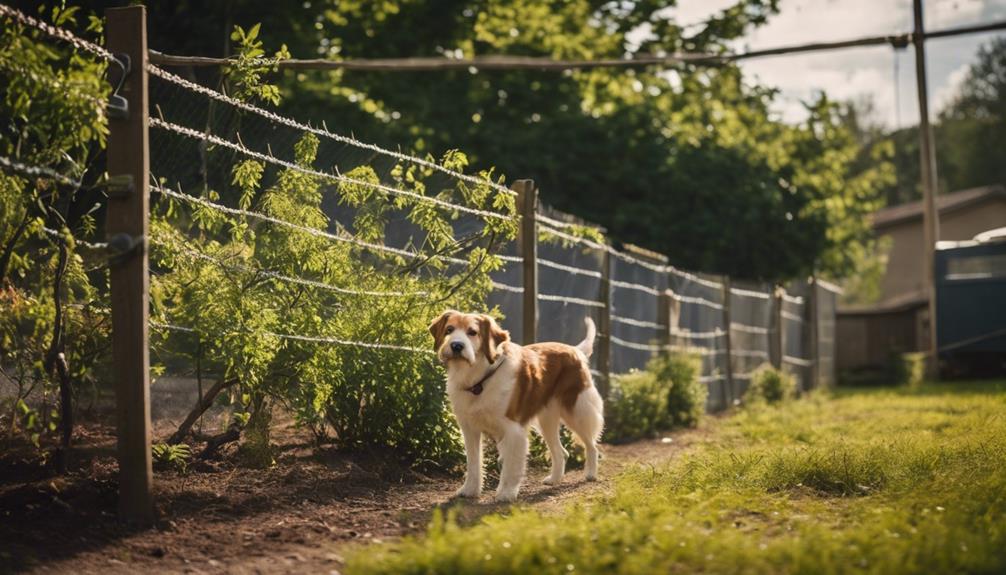
To keep our dogs safe from toxic elderberries, a forward-thinking approach is crucial. This includes knowing which berries are harmful, teaching our dogs to avoid them, and having a plan if something goes wrong. It’s about education, training, and being ready for emergencies. These steps help protect our dogs and stop bad things from happening again.
Understanding the dangers of certain berries and teaching our pets what not to eat is key. This means spending time with them and using training techniques that work. If an incident occurs, having an emergency plan in place can save valuable time and reduce panic. This approach ensures our dogs stay safe and healthy.
Recognize Toxic Berries
Knowing which berries are dangerous for dogs, including black bryony and white bryony, is key to keeping them safe. Elderberries can also be harmful unless they are prepared correctly, and certain parts of the plant should not be eaten. To protect our dogs, we should:
- Learn how to spot and stay away from harmful berries.
- Keep an eye on our dogs when they’re in areas where these berries might be found.
- If a dog does eat toxic berries, getting veterinary care quickly is vital for their health.
Berries like black bryony and white bryony can cause serious health problems for dogs, such as dehydration and stomach issues. This makes it important to prevent them from eating these berries and to act fast if they do.
Training Dogs Effectively
Acknowledging the dangers certain plants pose to dogs is critical, especially when it comes to elderberries. Training your dog to stay away from harmful plants is a must for their safety. Teach your dog commands like ‘leave it’ or ‘drop it’ effectively. Rewarding them with treats or toys when they obey is a great way to use positive reinforcement.
Creating a safe play area for your dog that’s away from toxic plants is wise. Always keep an eye on them when they’re outside. Putting up barriers or fences can help keep your dog away from areas with elderberry bushes, reducing the risk of them eating something they shouldn’t. These steps are key in protecting your dog from elderberries and other dangerous plants.
Emergency Plan Essentials
Creating an emergency plan with your vet is vital to quickly deal with elderberry poisoning in dogs. Since elderberry poisoning can lead to cyanide toxicity very fast, it’s crucial to get help from a vet right away. Tests on blood and urine are key for detecting cyanide, allowing for the right emergency care.
- Quick Vet Contact: Always have your vet’s emergency number ready.
- Know the Signs: Learn the symptoms of elderberry poisoning to act fast.
- Keep Dogs Safe: Prevent your dogs from going near elderberry plants.
Knowing these steps can greatly lower the danger of elderberry poisoning, showing why being prepared is key to avoiding serious harm.
Frequently Asked Questions
Is Elderberry Toxic for Dogs?
- Elderberry is harmful to dogs due to cyanide components.
- Always consult a vet before giving your dog elderberry.
- Myths about safe preparation don’t change elderberry’s risk.
Which Berries Are Toxic to Dogs?
- Avoid grapes and their relatives; they’re poisonous to dogs.
- Blueberries, raspberries, and strawberries are safe snacks.
- Cherries can be harmful; watch your dog closely.
How Does Elderberry Help Dogs?
- Elderberry boosts dog’s immune systems with vital vitamins.
- Offers antioxidants for healthy digestion and skin.
- Proper diet inclusion promotes canine well-being.
What if My Dog Eats Red Berries From the Bush?
- Identify the berries and consult a vet.
- Watch for signs of stomach upset.
- Call poison control for safety.

